All the solutions provided in McGraw Hill Math Grade 5 Answer Key PDF Chapter 10 Lesson 11 Divide Unit Fractions by Whole Numbers will give you a clear idea of the concepts.
McGraw-Hill My Math Grade 5 Answer Key Chapter 10 Lesson 11 Divide Unit Fractions by Whole Numbers
Math in My World
Example 1
Elijah is sorting his music into playlists. One-half of his music is rock. He wants to make 3 separate rock playlists. If each playlist is the same size, what fraction of Elijah’s music will be on one of the rock playlists?
Find \(\frac{1}{2}\) ÷ 3.
1. The model shows the amount of Elijah’s music that is rock.
Answer:
The rectangular model can be used to develop the understanding that fractions are parts of a whole, to compare fractions, generate equivalent fractions and explore operations with fractions.
The above-given:
1/2 ÷ 3
as per the equation given we need to draw the mode.
since the denominator is 2, we draw 2 equal sections.
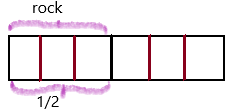

2. Divide each section into 3 equal parts.
How many equal sections are there now? _____
Answer:
In that 2 sections,
again in each section, we have to divide it into 3 parts.
Now if we count the parts in 2 sections then we get 6.
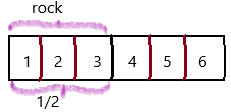
Therefore, 6 equal sections are there.
How many of the parts represent the fraction of the music that is on one of the rock playlists? ____
3. Write the fraction.

So, \(\frac{1}{2}\) ÷ 3 = ![]()
Check Use multiplication to check.
\(\frac{1}{6}\) × 3 = \(\frac{1}{6}\) × \(\frac{3}{1}\) = \(\frac{3}{6}\) or \(\frac{1}{2}\)
Answer:
The above-given equation:
1/2 ÷ 3
Now simplify the equation. Let the answer be R.
R = 1/2 ÷ 3
R = 1/2 x 1/3
R = 1/6
The fraction we got is 1/6.
Therefore, 1/6 of the parts represent the fraction of the music that is on one of the rock playlists.

Example 2
In the buffet line, there was only \(\frac{1}{4}\) of a pan of spaghetti left. Three friends decide to divide the spaghetti evenly. What fraction of a whole pan of spaghetti did each friend receive? Find the unknown
in \(\frac{1}{4}\) ÷ 3 = s.
1. The model shows \(\frac{1}{4}\).

Answer:
The rectangular model can be used to develop the understanding that fractions are parts of a whole, to compare fractions, generate equivalent fractions and explore operations with fractions.
The above-given:
1/4 ÷ 3 = s
as per the equation given we need to draw the mode.
since the denominator is 4, we draw 4 equal sections.
Each section is divided into 3 parts.

2. Divide each of the four sections into 3 equal parts. There are ___ total sections.
Answer:
The four sections were divided into 3 equal parts. Then the total number of sections will be 12
count the lines we drawn

3. Write the fraction.
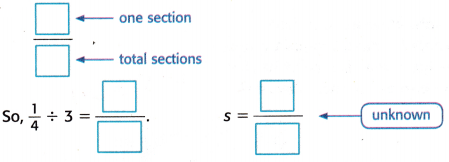
Each friend receives  of a pan of spaghetti.
of a pan of spaghetti.
Answer:
The above-given equation:
1/4 ÷ 3
Now simplify the equation. Let the answer be s.
s = 1/4 ÷ 3
s = 1/4 x 1/3
s = 1/12
The fraction we got is 1/12.
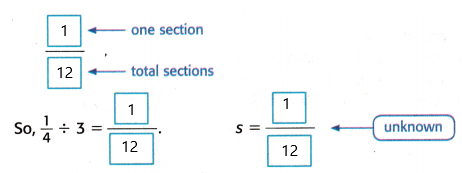
Each friend receives 1/12 of a pan of spaghetti.
Talk Math
What multiplication equation can you use to check your answer to Example 2? Explain.
Answer:
The above-given equation:
1/4 ÷ 3
Now simplify the equation. Let the answer be s.
s = 1/4 ÷ 3
s = 1/4 x 1/3 (multiplication equation)
s = 1/12
The fraction we got is 1/12.
The multiplication equation to check the answer is:
1/12 x 3 = 1/4
Hence, the answer is correct.

Guided Practice
Question 1.
Find the quotient of \(\frac{1}{3}\) ÷ 3. Use the model. Check using multiplication.

Answer:
The above-given
1/3 ÷ 3
The rectangular model can be used to understand that fractions are parts of a whole, to compare fractions, generate equivalent fractions and explore operations with fractions.
The above-given:
1/3 ÷ 3 = s
as per the equation given we need to draw the mode.
since the denominator is 3, we draw 3 equal sections.
Each section is divided into 3 parts.
The three sections were divided into 3 equal parts. Then the total number of sections will be 9
count the lines we drawn
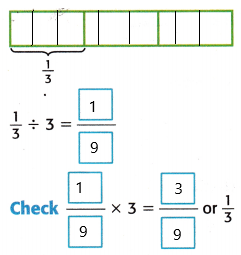
Independent Practice
Find each quotient. Use each model. Check using multiplication.
Question 2.
\(\frac{1}{2}\) ÷ 6 = ____

Check ____ × 6 = ____ or \(\frac{1}{2}\)
Answer:
The above-given:
1/2 ÷ 6
The rectangular model can be used to develop the understanding that fractions are parts of a whole, to compare fractions, generate equivalent fractions and explore operations with fractions.
The above-given:
1/2 ÷ 6 = s
as per the equation given we need to draw the mode.
since the denominator is 2, we draw 2 equal sections.
Each section is divided into 6 parts.
The two sections were divided into 6 equal parts. Then the total number of sections will be 12
count the lines we drawn

now we need to check by using the multiplication equation
1/12 x 6 = 1/2
Therefore, the answer is verified.
Question 3.
\(\frac{1}{7}\) ÷ 2 = ____

Check ____ × 2 = ____ or \(\frac{1}{7}\)
Answer:
The above-given:
1/7 ÷ 2
The rectangular model can be used to develop the understanding that fractions are parts of a whole, to compare fractions, generate equivalent fractions and explore operations with fractions.
The above-given:
1/7 ÷ 2 = s
as per the equation given we need to draw the mode.
since the denominator is 7, we draw 7 equal sections.
Each section is divided into 2 parts.
The seven sections were divided into 2 equal parts. Then the total number of sections will be 14
count the lines we drawn

Now we need to check the answer by using multiplication.
1/14 x 2 = 1/7
Therefore, the answer is reasonable.
Question 4.
\(\frac{1}{4}\) ÷ 4 = ____

Check ____ × 4 = ____ or \(\frac{1}{4}\)
Answer:
The above-given:
1/4 ÷ 4
The rectangular model can be used to understand that fractions are parts of a whole, to compare fractions, generate equivalent fractions and explore operations with fractions.
The above-given:
1/4 ÷ 4 = s
as per the equation given we need to draw the mode.
since the denominator is 4, we draw 4 equal sections.
Each section is divided into 4 parts.
The four sections were divided into 4 equal parts. Then the total number of sections will be 16.
count the lines we drawn

Now check the multiplication
1/16 x 4 = 4/16 = 1/4
Hence, the answer is reasonable.
Question 5.
\(\frac{1}{5}\) ÷ 2 = ____

Check ____ × 2 = ____ or \(\frac{1}{5}\)
Answer:
The above-given:
1/5 ÷ 2
The rectangular model can be used to understand that fractions are parts of a whole, to compare fractions, generate equivalent fractions and explore operations with fractions.
The above-given:
1/5 ÷ 2 = s
as per the equation given we need to draw the mode.
since the denominator is 5, we draw 5 equal sections.
Each section is divided into 2 parts.
The five sections were divided into 2 equal parts. Then the total number of sections will be 10
count the lines we drawn

Now check the answer using a multiplication equation.
1/10 x 5 = 5/10 = 1/2.
Question 6.
\(\frac{1}{2}\) ÷ 4 = ____

Check ____ × 4 = ____ or \(\frac{1}{2}\)
Answer:
The above-given:
1/2 ÷ 4
The rectangular model can be used to understand that fractions are parts of a whole, to compare fractions, generate equivalent fractions and explore operations with fractions.
The above-given:
1/2 ÷ 4 = s
as per the equation given we need to draw the mode.
since the denominator is 2, we draw 2 equal sections.
Each section is divided into 4 parts.
The two sections were divided into 4 equal parts. Then the total number of sections will be 8
count the lines we drawn
1/2 x 1/4 = 1/8

Now check the answer by using a multiplication equation.
1/8 x 4 = 4/8 = 1/2
Question 7.
\(\frac{1}{9}\) ÷ 2 = ____

Check ____ × 2 = ____ or \(\frac{1}{9}\)
Answer:
The above-given:
1/9 ÷ 2
The rectangular model can be used to understand that fractions are parts of a whole, to compare fractions, generate equivalent fractions and explore operations with fractions.
The above-given:
1/9 ÷ 2 = s
as per the equation given we need to draw the mode.
since the denominator is 9, we draw 9 equal sections.
Each section is divided into 2 parts.
The nine sections were divided into 2 equal parts. Then the total number of sections will be 18
count the lines we drawn
1/9 x 1/2 = 1/18

Now check the answer by using a multiplication equation
1/18 x 2 = 2/18 = 1/9.
Hence the answer is reasonable.
Problem Solving
Mathematical PRACTICE 5 Use Math Tools Draw a model to solve each problem.
Question 8.
One-fifth of the text messages that Natalie sends are to her family. She sends an equal amount of messages to her mom, dad, and sister. What fraction of all the text messages does she send go to her sister?
Answer:
The above-given
The text messages Natalie sends to her family = 1/5
The number of family members she sends messages to = 3 (mom, dad, sister)
The fraction of all the text messages she sends = X
X = 1/5 ÷ 3
Now simplify the equation
X = 1/5 x 1/3
X = 1/15
Therefore, 1/15th of all the text messages she sends go to her sister.
The model can be represented as:

We can check the answer by using the multiplication equation also.
1/15 x 3 = 3/15 = 1/5.
Hence, the answer is reasonable.
Question 9.
Asher has \(\frac{1}{2}\) ton of mulch to spread equally in 8 square yards. How many tons of mulch will be spread in each square yard?
Answer:
The above-given:
The ton of mulch Asher has = 1/2
The number of square yards spread equally = 8
The number of tons of mulch that will be spread in each square yard = T
T = 1/2 ÷ 8
T = 1/2 x 1/8
T = 1/16
Therefore, 1/16 tons of mulch is spread in each square yard.
The model can be represented as:

We can check the answer by using the multiplication equation also.
1/16 x 8= 8/16 = 1/2.
Hence, the answer is reasonable.
Question 10.
Hyun has \(\frac{1}{3}\) of his science project to complete still. He wants to spend an equal amount of time on his science project over the next 3 nights. What fraction of the science project will he complete each night?
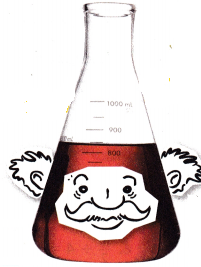
Answer:
The number of science projects to complete still = 1/3
The number of nights he wants to spend = 3
The fraction of the science project will he complete each night = P
P = 1/3 ÷ 3
P = 1/3 x 1/3
P = 1/9
Therefore, 1/9th of the science project he completes each night.
The model can be represented as:

HOT Problems
Question 11.
Mathematical PRACTICE 6 Be Precise Write and solve a real-world problem for \(\frac{1}{6}\) ÷ 4. Then explain the meaning of the quotient.
Answer:
The above-given:
1/6 ÷ 4
Let the quotient be q
q = 1/6 x 1/4
q = 1/24
The real-world situation would be Minnie had 1/6 of an hour remaining to complete 4 tasks. What fraction of an hour can Minnie spend on each task?
From the above simplification, we can say, Minnie can spend 1/24 of an hour on each task.
Question 12.
? Building Essential Question How can I use bar diagrams to divide unit fractions by whole numbers?
Answer:
The rectangular model can be used to understand that fractions are parts of a whole, to compare fractions, generate equivalent fractions and explore operations with fractions.
The above-given:
1/6 ÷ 4
as per the equation given we need to draw the mode.
since the denominator is 6, we draw 6 equal sections.
Each section is divided into 4 parts.
The six sections were divided into 4 equal parts. Then the total number of sections will be 24
count the lines we drawn
The bar diagram would be

McGraw Hill My Math Grade 5 Chapter 10 Lesson 11 My Homework Answer Key
Practice
Find each quotient Use each model. Check using multiplication.
Question 1.
\(\frac{1}{2}\) ÷ 3 = ____

Check ____ × 3 = ___ or \(\frac{1}{2}\)
Answer:
The rectangular model can be used to understand that fractions are parts of a whole, to compare fractions, generate equivalent fractions and explore operations with fractions.
The above-given:
1/2 ÷ 3
1/2 x 1/3 = 1/6
as per the equation given we need to draw the mode.
since the denominator is 2, we draw 2 equal sections.
Each section is divided into 3 parts.
The two sections were divided into 3 equal parts. Then the total number of sections will be 6
count the lines we drawn
The bar diagram would be

Now check the answer by using a multiplication equation.
1/6 x 3 = 3/6 = 1/2
Hence, the answer is reasonable.
Question 2.
\(\frac{1}{4}\) ÷ 5 = ____

Check ____ × 5 = ___ or \(\frac{1}{4}\)
Answer:
The rectangular model can be used to understand that fractions are parts of a whole, to compare fractions, generate equivalent fractions and explore operations with fractions.
The above-given:
1/4 ÷ 5
1/4 x 1/5 = 1/20
as per the equation given we need to draw the mode.
since the denominator is 4, we draw 4 equal sections.
Each section is divided into 5 parts.
The four sections were divided into 5 equal parts. Then the total number of sections will be 20
count the lines we drawn
The bar diagram would be

Now check the answer by using a multiplication equation.
1/20 x 5 = 5/20 = 1/4
Hence, the answer is reasonable.
Problem Solving
Draw a model to solve Exercises 3 and 4.
Question 3.
There is only one granola bar left out of a pan of 10 bars. If Will and Rachel decide to split the last granola bar, what fraction of the entire pan of granola bars will each friend receive?
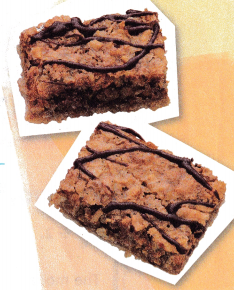
Answer:
The total number of granola bars = 10
The number of granola bars left = 1
The number of friends split the last granola bar = 2 (will and Rachel)
The fraction of the entire pan of granola bars will each friend receive = G
The equation would be:
G = 1/10 ÷ 2
G = 1/10 x 1/2
G = 1/20
The model can be represented as:

Question 4.
Mathematical PRACTICE 4 Model Math Tyson has \(\frac{1}{2}\) pound of raisins to divide equally into 7 different bags. What fraction of a pound will be in each bag?
Answer:
The above-given:
The number of raisins Tyson has = 1/2
The number of different bags = 7
The fraction of a pound will be in each bag = R
R = 1/2 ÷ 7
R = 1/2 x 1/7
R = 1/14
Therefore, 1/14 of a pound is in each bag.
The model can be represented as:

Question 5.
Mathematical PRACTICE 6 Explain to a Friend Write and solve a real-world problem for \(\frac{1}{2}\) ÷ 3. Then explain the meaning of the quotient.
Answer:
The above-given:
1/2 ÷ 3
The real-world situation is Annie has 1/2 an hour to make 3 biscuits. How much time she can spend on each biscuit?
Let the quotient be Q.
Q = 1/2 x 1/3
Q = 1/6
Therefore, she spends 1/6 of an hour on each biscuit.
Test Practice
Question 6.
There is \(\frac{1}{6}\) of a birthday cake left over. If 3 friends share the remaining cake equally, what fraction of the entire cake will each friend receive? Find the unknown in \(\frac{1}{6}\) ÷ 3 = p.

A. p = \(\frac{1}{16}\)
B. p = \(\frac{1}{18}\)
C. p = \(\frac{1}{21}\)
D. p = \(\frac{1}{24}\)
Answer: Option B is correct.

The above-given:
1/6 ÷ 3 = p
p = 1/6 x 1/3
p = 1/18
Therefore, 1/18th of the entire cake will each friend receive.